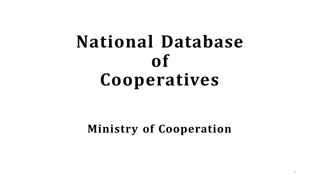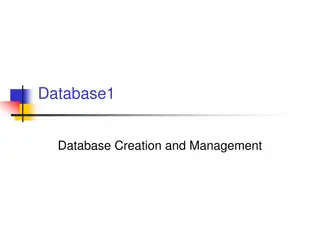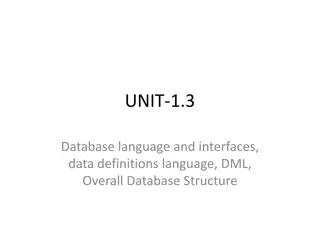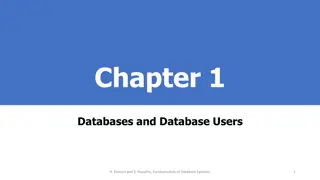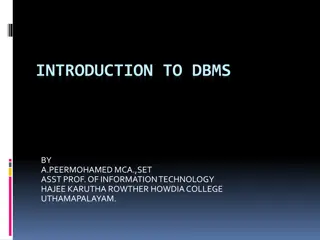Costs and Risks of Implementing a Database Approach
Implementing a database approach involves additional costs and risks that need to be managed effectively. From hiring specialized personnel to dealing with conversion costs and organizational conflicts, organizations must carefully consider the implications of transitioning to a database system. The need for explicit backup and recovery procedures, installation and management complexities, as well as potential conflicts within the organization can all impact the successful implementation of a database environment.
Download Presentation

Please find below an Image/Link to download the presentation.
The content on the website is provided AS IS for your information and personal use only. It may not be sold, licensed, or shared on other websites without obtaining consent from the author.If you encounter any issues during the download, it is possible that the publisher has removed the file from their server.
You are allowed to download the files provided on this website for personal or commercial use, subject to the condition that they are used lawfully. All files are the property of their respective owners.
The content on the website is provided AS IS for your information and personal use only. It may not be sold, licensed, or shared on other websites without obtaining consent from the author.
E N D
Presentation Transcript
Database System Instructor: Sadiq Shah (Lecture 02)
Costs and Risks of the Database Approach A database is not a silver bullet, and it does not have the magic power of Harry Potter. As with any other business decision, the database approach entails some additional costs and risks that must be recognized and managed when it is implemented. NEW, SPECIALIZED PERSONNEL INSTALLATION AND MANAGEMENT COST AND COMPLEXITY CONVERSION COSTS NEED FOR EXPLICIT BACKUP AND RECOVERY ORGANIZATIONAL CONFLICT 1. 2. 3. 4. 5.
Costs and Risks of the Database Approach NEW, SPECIALIZED PERSONNEL Frequently, organizations that adopt the database approach need to hire or train individuals to design and implement. Further, because of the rapid changes in technology, these new people will have to be retrained or upgraded on a regular basis. INSTALLATION AND MANAGEMENT COST AND COMPLEXITY A multiuser database management system is a large and complex suite of software that has a high initial cost, requires a staff of trained personnel to install and operate, and has substantial annual maintenance and support costs. Installing such a system may also require upgrades to the hardware and data communications systems in the organization. Substantial training is normally required on an ongoing basis to keep up with new releases and upgrades.
Costs and Risks of the Database Approach CONVERSION COSTS The term legacy system is widely used to refer to older applications in an organization that are based on file processing and/or older database technology. The cost of converting these older systems to modern database technology measured in terms of dollars, time, and organizational commitment may often seem prohibitive to an organization. NEED FOR EXPLICIT BACKUP AND RECOVERY A shared database must be accurate and available at all times. This requires that comprehensive procedures be developed and used for providing backup copies of data and for restoring a database when damage occurs. These considerations have acquired increased urgency in today s security-conscious environment.
Costs and Risks of the Database Approach ORGANIZATIONAL CONFLICT If strong top management support of and commitment to the database approach are lacking, end-user development of stand- alone databases is likely to proliferate. Experience has shown that conflicts on data definitions, data formats and coding, rights to update shared data, and associated issues are frequent and often difficult to resolve.
Components Of The Database Environment The major components of a typical database environment and their relationships
Components Of The Database Environment Computer-aided software engineering (CASE) tools: CASE tools are used to design databases and application programs. These tools help with creation of data models and in some cases can also help automatically generate the code needed to create the database. We reference the use of automated tools for database design and development throughout the text. Repository A repository is a centralized knowledge base for all data definitions, data relationships, screen and report formats, and other system components. A repository contains an extended set of metadata important for managing databases as well as other components of an information system.
Components Of The Database Environment DBMS: A DBMS is a software system that is used to create, maintain, and provide controlled access to user databases. E.g Sql Serve, Oracle Database A database is an organized collection of logically related data, usually designed to meet the information needs of multiple users in an organization. It is important to distinguish between the database and the repository. The repository contains definitions of data, whereas the database contains occurrences of data.
Components Of The Database Environment Application programs: Computer-based application programs are used to create and maintain the database and provide information to users. User interface: The user interface includes languages, menus, and other facilities by which users interact with various system components, such as CASE tools, application programs, the DBMS, and the repository. Data and database administrators: Data administrators are persons who are responsible for the overall management of data resources in an organization
Components Of The Database Environment System developers: System developers are persons such as systems analysts and programmers who design new application programs. System developers often use CASE tools for system requirements analysis and program design. End users: End users are persons throughout the organization who add, delete, and modify data in the database and who request or receive information from it. All user interactions with the database must be routed through the DBMS.



